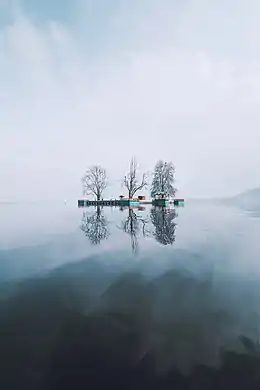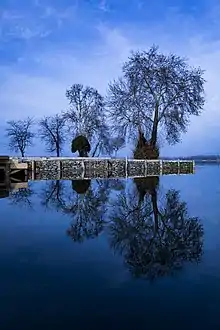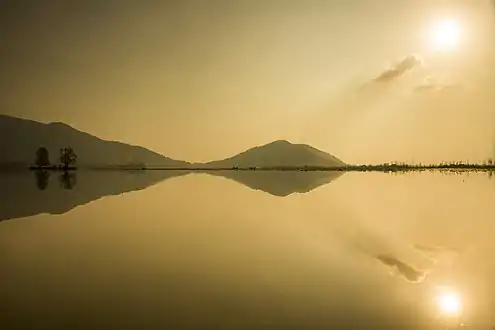Char Chinar
Char Chinar, also sometimes called Char Chinari, Ropa Lank, or Rupa Lank, is an island in Dal Lake, Srinagar, Jammu and Kashmir. Dal Lake includes 3 islands, 2 of which are marked with beautiful Chinar trees. The island located on the Bod Dal is known as Roph Lank (Silver Island), is marked with the presence of majestic Chinar trees at the four corners, thus known as Char-Chinari (Four Chinars).[1][2] The second Chinar Island, known as Sone Lank (Gold Island), is located on the Lokut Dal, and over looks the holy shrine of Hazratbal.[2]
 | |
| Geography | |
|---|---|
| Location | Dal Lake |
| Coordinates | 34.1004°N 74.8663°W |
History
Murad Baksh, brother of the Mughal emperor Aurangzeb, constructed the Roph Lank.[3]

Chinar
Chinar trees characteristically grow in Eastern Himalayas. There botanical name is Platanus orientalis. They have been an important part of Kashmiri tradition, in that, a Chinar tree is found in almost every village in Kashmir. These trees have survived for ages, because Chinar is basically a long-living tree. It spreads wide across a region of cool climate with sufficient water. The tree has several properties - leaves and bark are used as medicine, the wood, known as lace wood has been used for delicate furniture and the twigs and roots are used for making dyes.[4]
Decline and restoration
Chinar all over Jammu and Kashmir have been affected due to various reasons such as indiscriminate felling and floods. It is common to find locals and media houses reporting that the four chinar at Char Chinar no longer are as majestic as they use to be. Three of the four trees have shown signs of drying up. Some locals blame construction on the island whereas others blame recent floods and climate change.[5][6]
The floriculture department of Jammu and Kashmir is making efforts to restore the island to its former glory and have also planted more Chinar trees on the island.[3]
Gallery
References
- "The Geographer". The Geographer. 41: 24. 1994.
- Sharma, Shiv (2008). India - A Travel Guide. Diamond Pocket Books (P) Ltd. p. 816. ISBN 9788128400674.
- "The lost charm of Char Chinari". Archived from the original on 18 June 2018. Retrieved 17 June 2018.
- Ashiq, Peerzada (19 November 2015). "The speaking tree of Kashmir". The Hindu. ISSN 0971-751X. Retrieved 17 June 2018.
- "Dying Chinars enchant no visitors at Char Chinari". Kashmir Reader. Retrieved 17 June 2018.
- "Kashmir's famed Char Chinari island dying a slow death". The Tribune. 8 August 2017.




